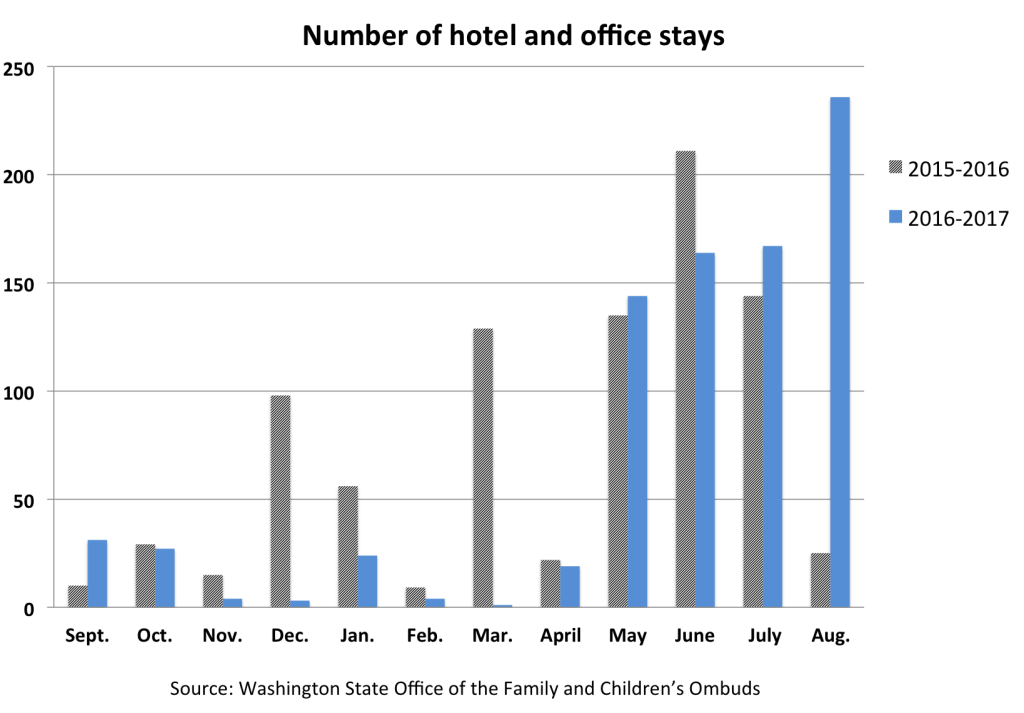It was close to 1:30 a.m., and two children who’d been taken from their homes by Washington Child Protective Services were still waiting in a Pierce County child welfare office for someone — anyone — to agree to take them in for a night. A worker posted a desperate plea on a Facebook page for foster parents that morning last June: “Insomnia anyone? Still up? The boys in Tacoma still need placement.”
Workers’ earlier posts had offered an “exceptional cost placement” for the teens. That’s code for payments that can top $600 a night — more than the base rate foster parents get for a whole month of care — as an incentive for foster parents to take a child.
Like hundreds of other Washington children removed from their caregivers due to suspected neglect or abuse in recent years, the boys likely spent the night curled up on couches in a state office or — if they were lucky — in a hotel room, supervised by two social workers who must stay up all night.
Faced with a severe, ongoing shortage of foster parents, the state Children’s Administration has grown desperate. To avoid placing children in hotels, it increasingly offers foster parents large sums to keep children from bedtime until breakfast, rather than pay three times as much to keep kids in hotels.
The payment of high per-night fees was first reported by InvestigateWest, Crosscut and KCTS9 last fall. Since then, InvestigateWest has learned that the top rate the state is willing to pay has nearly doubled over the last year from $325 to $600. And new payment records requested from the state, as well as confidential but incomplete data obtained by InvestigateWest, show that at least a handful of foster families are making a small fortune on the practice.

“Child mills” is how one social worker referred to some of these short-term homes that take a constant stream of kids while providing them with minimal care.
And yet, the state also continues to rely on hotels. August of this year saw the highest number of hotel stays — 236 — since the state’s child welfare ombuds began tracking the issue three years ago. Hotel stays cost around $2,100 per night, the state estimates. Children sleeping in offices also spiked over the summer in Pierce County, with social workers reporting up to a half-dozen children, some as young as 5, camped out in the office over the weekend.
The worsening trend of shunting foster children between expensive and substandard way stations highlights the ongoing dysfunction in the state’s child-welfare system.
Social workers say the situation has gotten so bad that they are second-guessing their decisions to remove children from abusive or neglectful circumstances because they can’t always guarantee a safe, stable alternative. “The state is not actually providing anything better,” said one Pierce County caseworker.
Bouncing children between hotels and short-term foster homes further traumatizes them, worsens any existing behavior problems and only makes children harder to place, child welfare experts say.
Meanwhile, such marginal care is costing taxpayers millions.
The state has spent an estimated $3.6 million housing foster kids in hotels over the last two years, according to figures provided by the department. Millions more have been paid out to foster parents who essentially function as hotels, although the state does not closely track that number.
Solutions are possible. Some observers say those funds could be better spent helping birth families so they can keep their kids and supporting foster parents who take on especially difficult youngsters.
“What is unconscionable about this situation is that neither foster home shortages nor the use of 24-hour placements and hotels is new in this state,” said Dee Wilson, a 26-year veteran of the Children’s Administration who now trains social workers. These practices, he said, have been going on at least since state lawmakers cut foster care funding by nearly one-quarter after the Great Recession, cuts that were never fully restored.
Earlier this year, the Legislature created a new Department of Children Youth and Families with the goal of consolidating and improving child welfare programs.
“Meanwhile, they have not attended to the urgent business at hand,” Wilson said.
Cashing in on the crisis
For a handful of foster parents, the high per-night fees can add up to a handsome income, especially when homes take in three or more kids at a time.
The state paid one Puget Sound-area foster home more than $725,000 over a recent two-and-a-half-year period, records obtained by InvestigateWest show. The hundreds of children who passed through the home mostly stayed for a few nights at most.
The Children’s Administration did not track the statewide cost of such incentive payments. But records obtained separately by InvestigateWest show that in Western Washington in 2016 alone, the state authorized incentive payments totaling $412,000 for just four homes. One of those received nearly $150,000 by taking in up to four teens at a time, each for $225 a night. By comparison, the highest standard foster care reimbursement for teens is just over $18,000 for a full year.
The payments for these temporary stays arranged by desperate caseworkers are extraordinary. Only three other foster families in the state have received more than $200,000 a year for “special supervision” of high-needs foster children, records provided by the Children’s Administration show. But those three families provided long-term care to a small number of disabled or medically fragile children, according to the department.
In contrast, the expensive night-by-night foster parents often provide little more than a place for children to sleep for eight hours.
In many cases, foster parents require social workers to drop children off late in the evening and pick up them early in the morning. Those children typically spend their days sitting in state offices — instead of in school — waiting to learn their fate for the next night. Social workers, many of whom already struggle to manage 25 or more cases — nearly double the recommended 12 to 15 — must babysit the children in their offices.
“So they [foster parents] are getting paid, and the social workers are doing all the work,” said one Pierce County worker who spoke on condition of anonymity out of fear of being fired.
Department leaders say they feel backed into a corner.
“I was at the place where I’m like, ‘Let’s write a blank check — I’ve got to get kids in safe, stable placements. There is no other alternative,’” Connie Lambert-Eckel, Children’s Administration acting secretary, told the House Early Learning & Human Services Committee during a January work session on expanding foster care placement options.
The shortage of foster homes and facility beds, especially for children with significant behavioral and mental health problems, reached a “crisis proportion” in the summer of 2015, Lambert-Eckel told lawmakers. Circumstances have not improved much since then.
The number of children removed from their homes has risen nearly 20 percent since 2012, with more than 8,800 now in the state’s care. Observers say much of the increase is likely due to the ongoing epidemic of addiction to heroin and prescription opioids. Today the state has just over 5,000 foster homes, which is about 1,000 fewer than it maintained in past decades.
That shortfall drives the demand for rising payments to foster parents. “Once you pay... it becomes an expectation rather than an exception,” Lambert-Eckel told InvestigateWest in August. “It creates a very unfortunate dynamic overall for us, and one that it’s very hard to withdraw from.”
Paying a select group of foster parents $600 a night could also make it harder to recruit more long-term foster parents. Standard monthly reimbursements range from $562 to $1,505, depending on the age and needs of the child, with higher rates available for children with special medical and behavioral needs.
Options: Could money be spent more humanely?
More humane — and potentially less costly — options to stabilize foster children are possible.
Instead of such highly nightly rates, the state should pay professional staff to support foster parents willing to take the most challenging children, said Mike Canfield, executive director of the Foster Parents Association of Washington State, which won a legal settlement requiring the state to increase foster parent reimbursements.
“Let’s spend $400 a day on staff to support foster parents, rather than send children back to offices to be watched by social workers," Canfield said. For example, trained workers could spend time in the home helping to supervise and counsel behaviorally troubled children. But, Canfield added, if parents are going have staff in their homes, they “need to be ready to think of foster parenting as their job. I think a lot of people would be willing to do that work if they knew they would be supported by the state.” In some cases when children act out, the alternative is calling 911.
In order to make caregiving their job, most foster parents would need a modest salary to replace lost income from outside work. For that reason, says Children’s Administration veteran Wilson, the state should train and pay some foster parents to be full-time, professional caregivers for the highest-needs children. At $1,000 or even $2,000 per month, for example, paying professional foster parents would be significantly cheaper than hotels or night-to-night placements — and better for foster youth. Recruiting well-meaning volunteers to care for the toughest kids “clearly isn’t working and isn’t likely to work in the near future,” Wilson said.
Investing more to support the families from which children are removed could also pay dividends, advocates for birth families say. Most children are removed for reasons of neglect rather than outright abuse, and a disproportionate number come from low-income families and families of color. That means help with basics like stable housing, child care and mental health treatment could keep more families together, especially if provided well before families fall into crisis.
“Most of the families that I assist right now, one of the greatest challenges is housing,” said Shrounda Selivanoff, whose daughter was temporarily removed by CPS a decade ago and who now helps other parents access services through the state Office of Public Defense. “So I think to myself, wow, $2,100 for one day,” she said, referencing the cost of a night’s hotel stay. “If we used that money for housing, it would have the long-term benefits of the child not lingering in care, and all of the expense that goes with that. Can Washington state invest in families?”
Many of the children cycling between hotels and short-term foster parents face severe mental health and behavioral challenges. For them, temporary stays in well-run group facilities, while not ideal, “beat the heck out of 24-hour placements and use of hotels,” Wilson said. But stagnant reimbursement rates have forced many facilities that contract with the state to reduce capacity or shutter altogether.
The Children’s Administration would like to reverse that trend, said acting secretary Lambert-Eckel, but the state’s low rates have made providers “rather cool” to the idea. The department will ask the Legislature to fund a rate study, “so we can actually get these providers to the true cost of care,” she said.
State leaders also pin their hopes on reforms under the new Department of Children, Youth and Families, which will take over foster care and other child welfare functions starting next July.
The need for systemic changes is a major reason Rep. Kagi championed the new department, she said. “I just think we need to ... be more focused on what the needs are and how we can improve outcomes. And that just has not been the case."
Ross Hunter, the DCYF secretary, said he’s still in the process of collecting ideas for improving the system, but some early proposals include better managing the lengthy foster parent licensing process, and making sure caregivers have access to 24-hour help from the state.
Hunter says he wants to increase the supply of foster parents, while also reducing the demand for foster care. The new department needs to “get further upstream” to help children before they are so traumatized that they are nearly impossible to place, he said. “And I admit that this is a long-term strategy. But that’s what you've got to do."
It’s also likely to be a costly strategy, at least in the near term. And it’s uncertain whether state lawmakers will have the appetite for big new child welfare expenditures, crisis or no crisis.
This story was supported by a grant from the Fund for Investigative Journalism.



